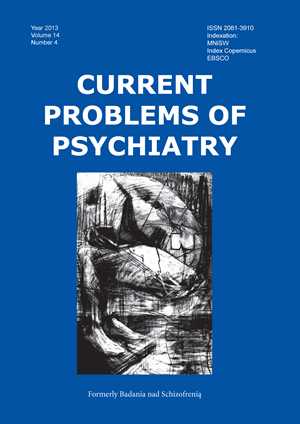Risk of Internet addiction among secondary school children
Keywords:
addiction, school children, the InternetAbstract
Introduction. The increasingly universal access to computers and the Internet has numerous positive aspects. However, the fact that using the Internet may also create a threat to the correct physical, psychological, intellectual, social or moral development, must not be overlooked.
Aim. To assess the risk of Internet addiction among secondary school children in Bialystok
Material and methods. The study was conducted from December 2010 to March 2011 among the students of 8 gymnasia in Bialystok. A group of 320 students aged 13-15 years was investigated with a questionnaire survey designed by the authors.
Results. Most respondents had a computer with the Internet access at home (97.5%) and used the Internet every day (69.1%). Every tenth respondent declared that he or she always used the Internet longer than planned. Almost 10% of the respondents continually thought about what they would do after switching on the computer or logging in to the Internet. In the case of every eighth student, people from their immediate environment reproved them for spending too much time on the Internet. Internet-dependency was reported by 11.6% of the students , while 5.3 % devoted over 5 hours a day to using the Internet.
Conclusion. To make it possible for computers and the Internet to play a useful role, education of children, youth, as well as their parents and guardians, in this field is necessary.
References
1. Kirwil L. Wzorce korzystania z Internetu przez dzieci w wieku 13-15 lat, s. www.brpd.gov.pl
2. Young K.S. Internet addiction: The emergence of a new clinical disorder. CyberPsychology and Behavior, 1996;1(3): 237-244.
3. Wołpiuk-Ochocińska A. Uzależnienie od Internetu – przybliżenie zjawiska. Studia z psychologii w KUL. Tom 13. Lublin: Wyd. KUL: 2006, s. 99-119.
4. Krajewska-Kułak E. i wsp. Uzależnienie od Internetu wśród studentów kierunku pielęgniarstwo. Probl. Hig. Epidemiol., 2010; 91(1): 41-47.
5. Pawłowska B., Potembska E. Objawy zagrożenia uzależnieniem i uzależnienia od Internetu mierzonego Kwestionariuszem do Badania Uzależnienia od Internetu, autorstwa Pawłowskiej i Potembskiej u młodzieży polskiej w wieku od 13 do 24 lat. Curr. Probl. Psychiatry., 2011; 12(4): 439-442.
6. Woronowicz B.T. Bez tajemnic o uzależnieniach i ich leczeniu. Warszawa; Wyd. Instytutu Psychiatrii i Neurologii: 2001.
7. Miedziński D., Krajewska-Kułak E., Kowalczuk K. Ocena zagrożenia wybranymi uzależnieniami w populacji studentów kierunku fizjoterapia. Probl. Hig. Epidemiol., 2013; 94(3): 583-593.
8. Godala M., Borek J., Szatko F. Ryzyko uzależnienia od Internetu wśród młodzieży gimnazjalnej. Probl. Hig. Epidemiol., 2013; 94(2): 226-232.
9. Krajewska-Kułak E. Problem zagrożenia uzależnieniem od Internetu wśród studentów kierunku fizjoterapia. Pielęgniarstwo XXI Wieku, 2010; (3-4): 31-39.


